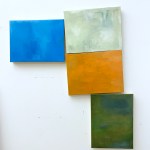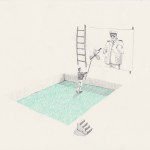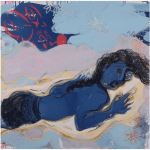Contributed by Katarina Wong /�The Getty recently launched�Pacific Standard Time: LA/LA,�a highly ambitious and rewarding initiative that explores Latin American and Latino art �in dialogue� with the city itself. More than 70 art institutions are participating, each offering their own take on the topic. One notable exhibition, among a field of exemplary shows, is�Radical Women: Latin American Art, 1960�1985�presented by the Hammer Museum.�
Radical Women shines a light on a sector of the art world long overlooked: women working in Latin American countries and US-born women artists of Latino descent. During a time when male artists dominated painting, this exhibition reveals the wide range of artistic practices these women explored. The exhibition features more than 100 artists from 15 countries, weaving their work against the political upheaval of the time. Seeing these pieces now, 50 years later, their urgency, power, and freshness are undeniable, especially set within the superb design of the show itself.

The show is divided between two large exhibition areas at the Hammer. As the viewer leaves one to go to the other, she is confronted by a long timeline, spanning an exterior wall. This timeline is particularly important to understanding the political and cultural backdrop in which these artists are working within. The wall features brief historical timelines for each of the countries represented in the exhibition. It notes revolutions and dates of independence, when women were given the right to vote, to divorce, to obtain legal abortions. Throughout Latin America – including the U.S. – women artists were working within a context of great cultural and political upheaval. They were not just reacting to their times but were also actively positing a different kind of world.
Running throughout the exhibition are political and cultural themes married to metaphors connected to the (female) body, reproduction, birth and death, communication (or lack thereof), sexual play, resistance, and perseverance.
In the first gallery, Peruvian artist Victoria Santa Cruz�s powerful 1978 performance�Me�gritaron�negra�(They shouted black at me),�sets a tone of defiance and resilience. In the video, Santa Cruz repeats the title and response ��Y�qu�?� (�So what?�) as a way to simultaneously (literally) call out the discrimination she experienced as well as see her blackness as a source of pride.

In Brazilian artist Vera Chaves�Barcellos��Epidemic�Scapes�(1977/82), she uses areas of her own skin rubbed with ink to create negatives blown up into photographs. The patchwork installation suggests a landscape both familiar and unknown.

A number of videos are installed around the perimeter of�Barcellos� large floor piece.�Lygia�Pape�s�O�ovo�(The egg) is a 1967 short film depicting a simulated birth via a cube placed on the edge of a lonely beach. Her video is paired with fellow Brazilian artist�Celeida�Tostes��Passagem�(Passage) from 1979, a photo performance consisting of 21 projected photographs showing the nude artist being encased in a clay vessel, eventually breaking through it in an act of creative birth.

Across the room, two other projections are paired: Ana�Mendieta�s�Coraz�n�de�roca�con�sangre�(Rock heart with blood) in which the Cuban artist lowers herself into a silhouette-shaped crevice hewn into the rock with�Silv�a�Gruner�s�Arena�(Sand) performance video, in which she coats her nude body with sand from the shore. Both artists poignantly seem to be trying to disappear into the land, not merely as a form of camouflage, but as refuge.

In a section that focuses on self-portraiture, Venezuelan artist Marisol�s�Self-Portrait�(1961-62) features seven heads, two arms, two breasts, and six legs all jutting out single large block of wood. These conjoined selves can be read as a psychological depiction as well as a collective social body struggling to keep whole.

Peruvian artist Teresa�Burga�s�Autoretrato.�Estructura. Informa, 9.6.1972�(Self-portrait. Structure. Report, 9.6.1972) collapses a single day – September 6, 1972�-�into an installation divided into three areas: Face report, Heart report, and Blood report. Each section is a collection of drawings, medical records, sound recordings, and other documentation of her body.

In another Ana�Mendieta�piece,�Untitled (Facial Hair Transplant),�1972 (estate print 1997), we see her gluing the shavings of a friend�s beard onto her own. Over the course of the photographs, we see the signifiers of her gender shifting and markers of beauty transforming.

Aparato�reproductor�de la�mujer�(Woman�s reproductive system), 1972, by Venezuelan artist Margot�R�mer, directly relates the body with a functional object through the list of parts of the female reproductive system as a wry comment on traditional women�s roles. She also humorously includes reference to the male reproductive system with the large phallic cactus placed in front of the open window.

La�Briosa,�1981 from the series “La�doble�lucha�(The double struggle)”, 1981-2005,��by Mexican artist Lourdes�Grobet�is one of several pieces that look at motherhood�s many complications and competing priorities.�La�Briosais�a photograph is from a series on�Luche�Libre wrestlers and depicts a mother, in her wrestler�s mask, tenderly caring for her child.

No exhibition covering this Latin American art can overlook the terrible disappearances particularly endemic – though not limited – to that time period. Chilean artists�Lus�Donoso�s�Huincha�sin fin�(Endless band), 1978, of photocopied portraits of many who were disappeared, and�Gracia�Barrios�s�painting of citizens rising out of the darkness in�Am�rica no�invoco�tu�nombre�en�vano�(American, I don�t take your name in vain), 1970, presents both the loss and also the resistance rising up during that time; while Colombian artist Sonia Gutierrez�s painting�Y con�unos�lazos�me�zaron�(And they lifted me up with rope), 1977, was inspired by a specific account and description of torture that Dr. Olga L�pez endured with her five-year-old daughter.

Working through themes of the body, the body politic, and resistance, the final room of the exhibition focuses again on the body, though in more playful, sexual ways.�Colch�n�(Bed) from 1964 by Argentinean artist Marta�Minuj�n, is a construction that both references the body as well as the activities that occur in bed. With the placement of�Colch�n�on the wall, it�s hard not to think of Robert Rauschenberg�s�Bed�from 1955. In that piece, he literally uses bed sheets and a pillow as the canvas.�Minuj�n, on the other hand, is exploring the relationship of the bed to human behavior – sleeping, sex, play. The bright colors, folds, and puffed forms beg for interaction and these sculptures led to installations in which the public was encouraged to walk through and interact with the shapes.

Another nod to the sexual revolution is Colombian artist�Feliza�Bursztyn�s�Cama�(Bed),� (assemblage with stainless steel scrap, cot, satin sheet, and engine), 1974. Her red satin-draped sculpture intermittently shivers and shakes as the imaginary couple below engage in their playful activities.

�Radical Women: Latin American Art, 1960�1985� Hammer Museum, Los Angeles, CA. Through December 31. The exhibition�travels to the Brooklyn Museum April 13-July 22, 2018 and then to Pinacoteca de S�o Paulo: August�November 2018.
About the author: Katarina Wong is an�artist�and the founder and curator of�MADE, New York. She is also the program manager of the Arts Administration graduate program at Teachers College Columbia University. Follow her on�Instagram,�Facebook�and�Twitter.
Related Posts:
Rewriting history: two surveys of Latin American art
Latin American abstraction, 1930s-1970s















Oh how I wish I were in LA, to experience this exhibition. Thank you for sharing it, Katarina Wong!
Katarina…great article! xx, Jamie